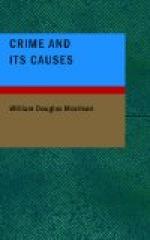In what way does a rise in temperature act on the individual so as to make him less capable of resisting the criminal impulse? This is a question of some difficulty, deserving more attention from physiologists than it has yet received. It is a satisfactorily established conclusion that the higher temperature of the summer months has a debilitating effect on the digestive functions; it is also believed that these months have an enervating effect on the system generally. In so far as the heat of summer produces disease, it at the same time tends to produce crime. Persons suffering from any kind of ailment or infirmity are far more liable to become criminals than are healthy members of the community. The intimate connection between disease and crime is a matter which must never be forgotten. In the present instance, however, the closeness of this connection is not sufficient to account for the growth of crime in summer. According to the Registrar General’s report for 1889 the death rate in the twenty-eight large towns is less in the six months from June to November than in the six months which follow. There is, therefore, less disease at the very time when there is most crime. In the face of this fact it cannot be contended that disease, generally, pushes the population into criminal courses in summer.
But while this is so, it may yet be true that some special enfeeblement (generated by the rise of temperature) which does not assume the acute form usually implied in the name, disease has the effect of stimulating impulses of a criminal character, or of weakening the barrier which prevents these impulses from breaking out and carrying all before them. It is a perfectly well-established fact that a high temperature not only produces physical enfeeblement, but that it also impairs the usual activity and energy of the brain. In other words, a high temperature is invariably accompanied by a certain loss of mental power. In most persons this loss is comparatively trifling, and has hardly any perceptible effect on their mode of life and conduct; in others, it assumes more serious proportions. In some who are susceptible to cosmical influences, and for one reason or another are already on the borderland of crime, the decrease of mental function involved




